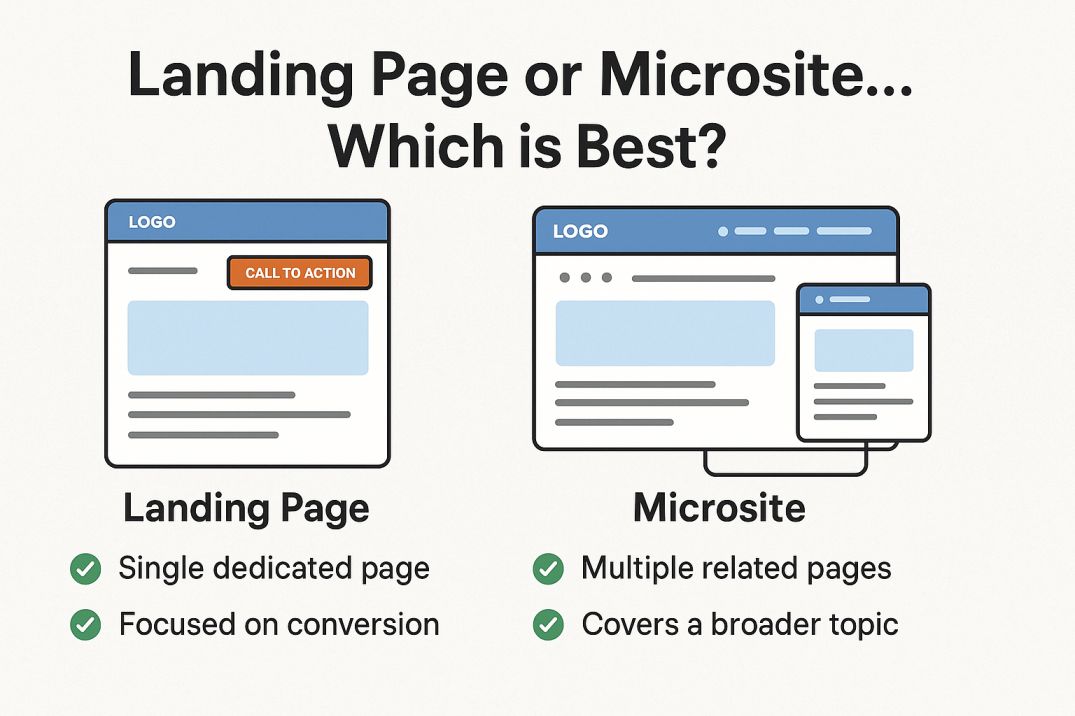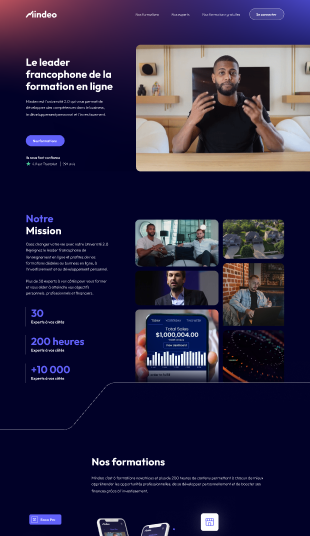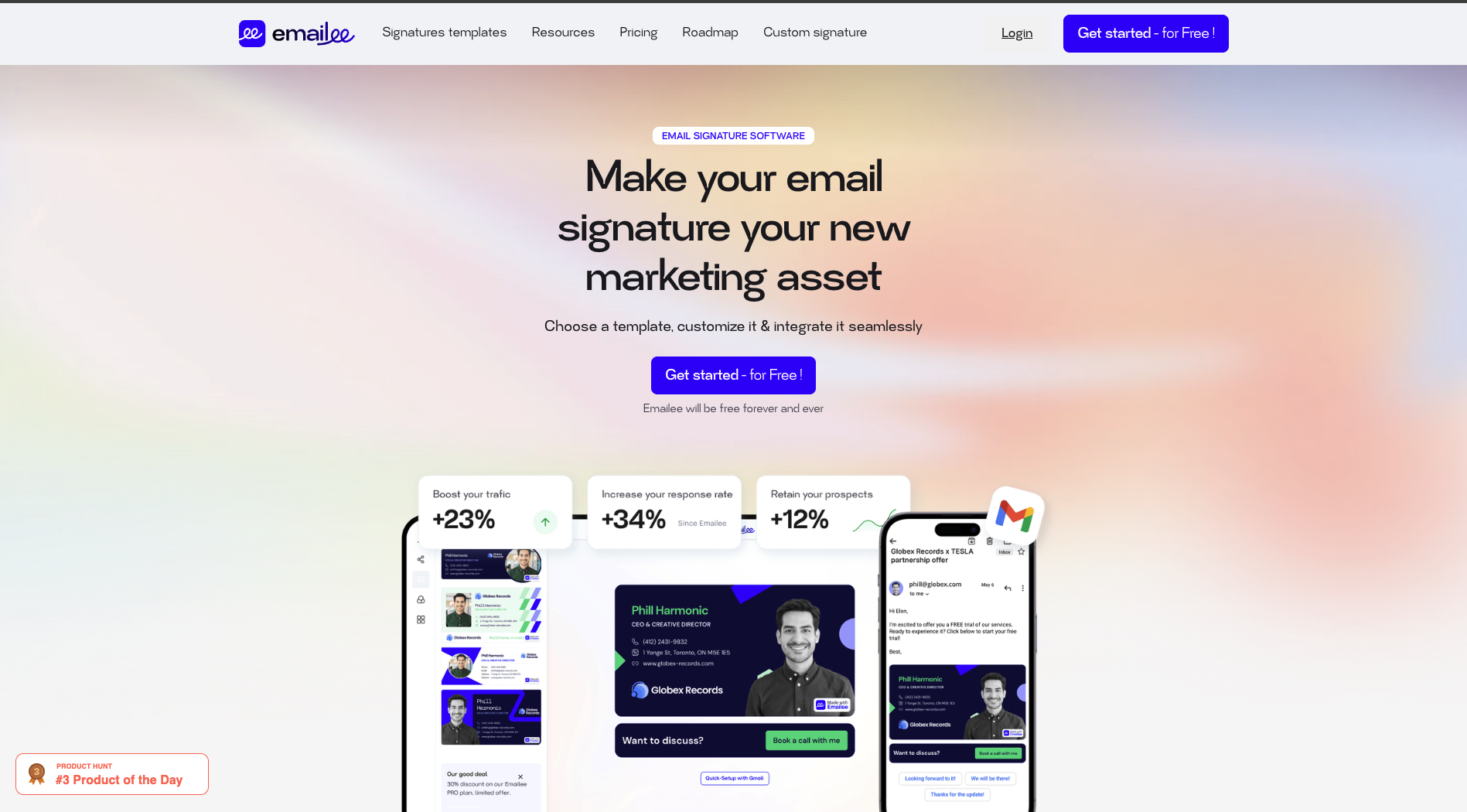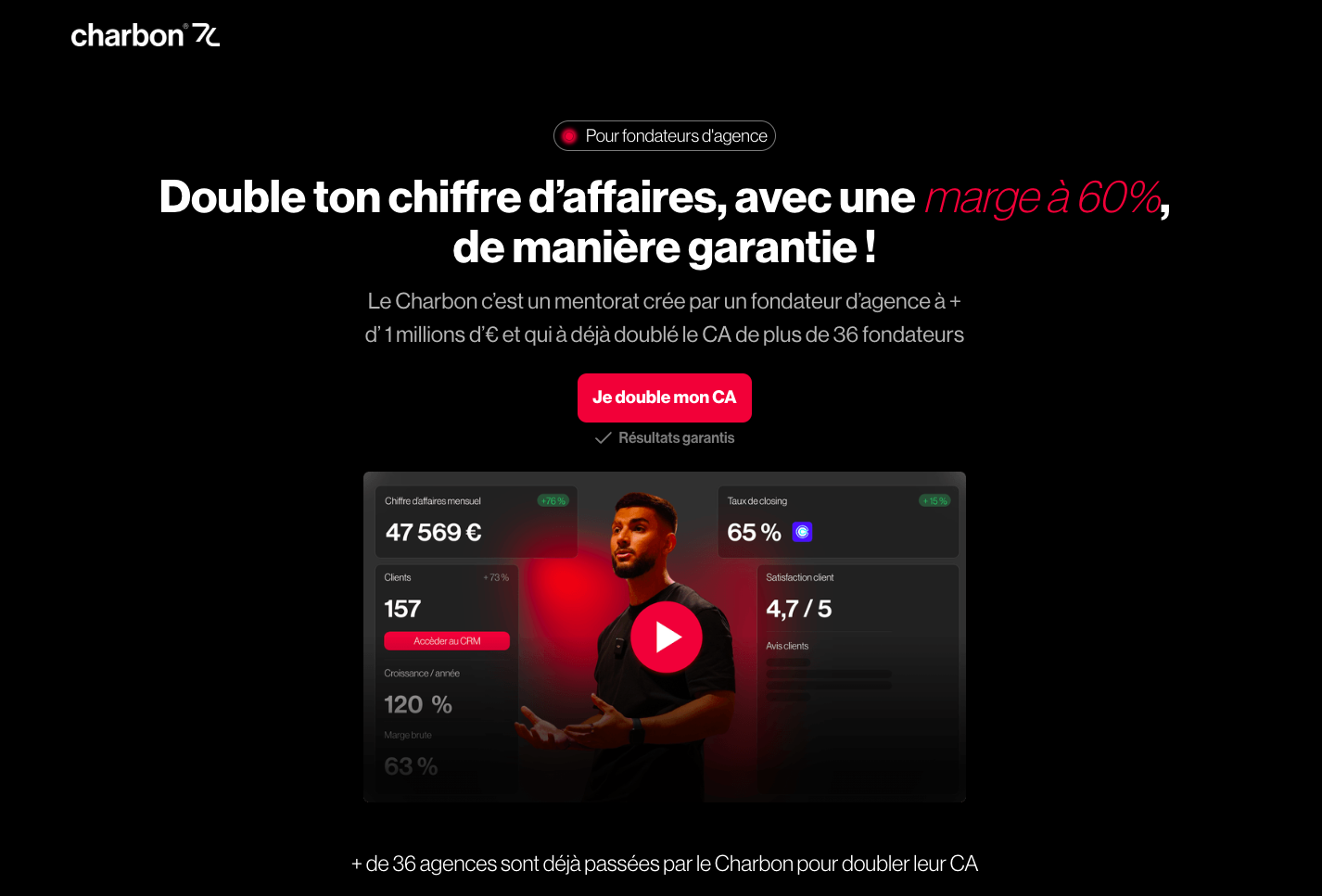Digital transformation is reshaping the fundamentals of web marketing: choosing between a microsite and a landing page means deciding which strategic angle best suits your objectives.
While a landing page attracts marketers with its simplicity and instant conversion potential, a microsite captivates through its immersive experience and ability to showcase rich, engaging content.
Brands juggle between these two formats to meet specific needs—lead generation, brand storytelling, temporary promotions, or interactive innovation.
Though the line between a microsite and a landing page can seem subtle, it’s a crucial one for digital performance.
In a world where every click counts, understanding how each structure works is an essential lever for improving your marketing efficiency.
Microsite vs Landing Page: Definitions and Core Differences
What Is a Microsite? Key Features and Concepts
A microsite is an autonomous mini-website, usually hosted on its own domain or subdomain.
Unlike the main company website, it focuses on a single theme—often tied to a specific campaign, product launch, or brand universe.
A microsite offers great creative freedom, allowing teams to move beyond the visual and structural limitations of the main site.
In concrete terms, it includes several interconnected pages with smooth internal navigation, creating an immersive user experience.
The richness of its content encourages deeper storytelling and often integrates interactive, multimedia, or even gamified elements.
This flexible structure makes it ideal for temporary or long-term educational or event-based initiatives.
Main features of a microsite:
- Multi-page mini-website
- Immersive experience and cross-page navigation
- Creative and editorial freedom
- Technical independence
- Often used for thematic or event-based marketing
This format stands apart from a landing page due to its ability to generate long-term engagement, support multiple key messages, and strengthen organic SEO performance.
What Is a Landing Page? Architecture, Uses, and Key Traits
A landing page—also called a destination or conversion page—is a single web page designed to welcome visitors after a targeted action: clicking on an ad, a newsletter, a social media link, or an email campaign.
Its structure is intentionally simple: minimal navigation, clean design, and zero distractions. Everything drives toward one goal—most often, immediate conversion (purchase, signup, or download).
The strength of a landing page lies in its ability to isolate visitors from distractions present on the main website.
A single message, a concise argument, and a clear call-to-action (CTA) are combined to maximize efficiency.
This setup allows for quick implementation, adaptability for short-term campaigns, and precise performance tracking.
Main features of a landing page:
- Single web page focused on one goal
- Strictly limited navigation
- Minimalist design
- Conversion or data collection oriented
- Easy to track and analyze
It’s the power tool of modern digital marketing, where every interaction must be measured, optimized, and turned into tangible results.
Functional Characteristics: Architecture, Navigation, and User Experience
Microsite: Multi-Page Navigation and Immersive Experience
At the heart of a microsite lies its multi-page navigation, creating a smooth journey often enhanced with animated transitions, storytelling sequences, or interactive elements.
This structure gives users the impression of entering a dedicated universe where each page reveals a new layer of the campaign or story.
For instance, the “IceCreamHeroes” microsite, created by a food brand for summer 2023, offered an immersive menu featuring new flavor stories, interactive games, production videos, and behind-the-scenes footage. The diversity of its content kept visitors fully engaged.
This immersion translates into a longer average session duration, increasing how deeply visitors absorb brand messages.
The multi-page setup also enables segmentation by theme, stage, or character, though it requires more time and resources for design and graphic development.
Microsite features:
- Customized navigation and interactive storytelling
- Multi-step user paths
- Possible integration of gamification or learning modules
- Ability to handle multiple CTAs
The immersive experience of a microsite clearly contrasts with the minimalist efficiency of a landing page, which focuses on direct action.
Landing Page: Streamlined Structure and Optimized Conversion Path
A landing page is built for maximum efficiency: linear architecture, no menus, and minimal distractions.
From the moment visitors arrive, they understand the purpose—sign up, purchase, download, or request information.
By removing nearly all secondary navigation, this design focuses attention on one message, one benefit, and one CTA.
The experience is quick, reassuring, and free from unnecessary friction.
This is the go-to structure for advertising campaigns and short-term promotions, where too much content could hinder the decision-making process.
Landing page features:
- Linear user flow
- Singular, visually compelling CTA
- Clean structure to maximize conversion rate
- Simplified performance analysis
With such precision, the landing page becomes a powerful weapon to turn every click into a measurable result.
Strategic Uses: When to Choose a Microsite or a Landing Page

Microsite: Event Campaigns, Education, and Gamification
When should you bet on a microsite?
This tool shines during event-based campaigns (trade shows, launches, or brand anniversaries), as well as for educational initiatives or high-value communication campaigns.
Take the example of “ExploreGreenTech2025”: a microsite dedicated to sustainable innovations that featured interviews, video tutorials, case studies, and interactive quizzes—all within an engaging design.
A microsite is relevant whenever you need to deepen understanding, persuade, or educate beyond a simple message.
It often becomes a true customer engagement laboratory, hosting guided journeys, segmented product catalogs, training modules, or playful learning tools.
Its multi-page layout also allows for the creation of reusable content archives.
Ideal for:
- Temporary events, trade shows, thematic conferences
- Educational content, tutorials, interactive guides
- Gamification tools, contests, and online challenges
Landing Page: Product Promotion, Lead Generation, and Rapid Conversions
The landing page excels in managing campaigns that require an immediate response.
It’s ideal for promoting a single product, collecting webinar sign-ups, downloading a white paper, or generating leadsquickly.
A striking example: a SaaS company tripled its client base in six months through a series of highly targeted landing pages, each focused on a specific offer.
Best suited for:
- Product or service launches
- Google Ads, Meta campaigns, and email marketing
- Event registrations, certifications, free trials
- Lead generation and qualification
Thanks to its simplicity, no-code adaptability, and analytical precision, the landing page has become the cornerstone of digital marketing performance.
Real-World Examples Across Industries
The range of microsite and landing page applications delivers proven results across every industry.
In fashion, a French brand launched a microsite on a dedicated subdomain for its Spring 2024 capsule collection. Visitors could explore behind-the-scenes videos, designer interviews, and exclusive offers—boosting organic search traffic.
Conversely, a clean, focused landing page for a music streaming service subscription drove a 28% increase in conversion rate during a short social campaign.
Industry use cases:
- Tourism: Microsite to showcase destinations, experience books, and local partners
- Real estate: Landing page dedicated to a premium property, enabling instant appointments
- Healthcare: Educational microsite on prevention, with explanatory videos and downloadable guides
Microsite vs Landing Page: Key Differences in Objectives, Resources, and Lifespan
Primary Goals: Instant Conversion vs Deep Engagement
The microsite vs landing page comparison begins with their core objectives.
A landing page is built for urgency—it’s designed to turn a click into an immediate action with no distractions. Ideal for instant conversion, it focuses on one clear objective. Its success is measured by the speed of execution and the conversion rate of the desired action.
The microsite, on the other hand, aims to build a more lasting connection, creating a self-contained world or developing a richer narrative. Its purpose is to deliver an experience—to educate, entertain, or explain complex offers and brand innovations.
This depth fosters memorability and loyalty, though it can sometimes come at the expense of short-term results.
Landing page: Focused on immediacy and high conversion rates
Microsite: Built for depth, affinity building, and long-term engagement
Ultimately, the choice depends on the campaign’s intent: do you need an immediate result or a lasting impact?
Resources, Timelines, and Costs: Practical Implications
Creating a microsite requires more substantial resources—content strategy, custom design, technical development, and advanced editorial tools. Timelines are necessarily longer, making this format suitable for large-scale or long-term campaigns.
Conversely, a landing page benefits from speed: standardized templates, no-code tools, and minimal need for advanced technical skills. Costs, lifespan, and the level of required involvement are therefore significantly reduced.
Microsite, Landing Page, or Full Website: Positioning Within a Digital Strategy
Strategic Comparison: Complementary Uses for Maximum Impact
In the broader digital ecosystem, a full website serves as the main institutional or commercial showcase—it hosts corporate information, news, a complete catalog, and customer support.
Meanwhile, the microsite and landing page play more tactical and complementary roles. They allow brands to address specific audiences or objectives without altering the structure or tone of their primary site.
Landing page: Short-term performance tool designed for campaign conversion
Microsite: Thematic exploration space for creative testing and immersive storytelling
Website: Global, institutional, and long-term presence
An effective digital strategy often involves orchestrating these formats together. For example, during an event launch, a microsite can centralize all information and enhance the experience, while landing pages handle event registrations or limited-time offers.
Choosing Between Microsite and Landing Page: Practical Criteria and Methodological Tips
Before deciding between a microsite and a landing page, it’s essential to clarify your marketing goals, content depth, and desired level of personalization. Consider the following checklist:
- The main objective: instant conversion or long-term engagement?
- The volume and variety of content to be published
- The budget and technical resources available
- The timeline of the campaign: urgency or gradual deployment?
- The target audience: attention span, maturity, and familiarity with your brand
In any case, the rise of no-code platforms and CMS editors now makes it easier than ever to build either lightweight microsites or high-performing landing pages, without requiring advanced technical expertise.
In summary: the best format is the one that perfectly fits the context of your goals while supporting your KPIs and growth objectives.
FAQ – Microsite vs Landing Page
Can you create a microsite or landing page without coding skills?
Yes. Modern no-code tools and CMS platforms make it easy to create both landing pages and microsites, even without advanced web development knowledge.
Which format is best for SEO?
The microsite is generally more effective for SEO because of its multi-page structure, content depth, and ability to target multiple keywords naturally.
What’s the difference between a homepage and a landing page?
The homepage is the main entry point of a website, designed to guide users to different sections. A landing page, on the other hand, focuses on one specific action and is built solely to drive conversions.
Can you combine a microsite and landing page in the same campaign?
Absolutely. Many companies use a microsite to create an immersive experience and landing pages to convert visitors, maximizing the overall campaign impact.
When should you use a microsite instead of a regular website?
A microsite is ideal for showcasing a campaign, event, or complex thematic content without altering the main website. It offers creative independence and custom storytelling, making it perfect for high-impact, temporary operations.












